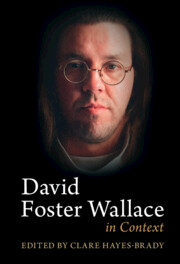Book contents
- David Foster Wallace in Context
- David Foster Wallace in Context
- Copyright page
- Contents
- Figures
- Contributors
- Acknowledgments
- Abbreviations
- Introduction
- Part I Contexts
- Part II Ideas
- Part III Bodies
- Chapter 20 No Ordinary Love
- Chapter 21 “The Limits of His Seductively Fine Mind”
- Chapter 22 David Foster Wallace and Masculinity
- Chapter 23 Theorizing the Other
- Chapter 24 David Foster Wallace and Disability
- Chapter 25 Queering Wallace
- Part IV Systems
- Works by David Foster Wallace
- Bibliography of Secondary Sources
- Index
Chapter 25 - Queering Wallace
On the Queer History of Addiction Fiction
from Part III - Bodies
Published online by Cambridge University Press: 18 November 2022
- David Foster Wallace in Context
- David Foster Wallace in Context
- Copyright page
- Contents
- Figures
- Contributors
- Acknowledgments
- Abbreviations
- Introduction
- Part I Contexts
- Part II Ideas
- Part III Bodies
- Chapter 20 No Ordinary Love
- Chapter 21 “The Limits of His Seductively Fine Mind”
- Chapter 22 David Foster Wallace and Masculinity
- Chapter 23 Theorizing the Other
- Chapter 24 David Foster Wallace and Disability
- Chapter 25 Queering Wallace
- Part IV Systems
- Works by David Foster Wallace
- Bibliography of Secondary Sources
- Index
Summary
That David Foster Wallace designed his fiction to serve a therapeutic function for readers is, at this point, axiomatic. Timothy Aubry (Reading as Therapy) has effectively demonstrated how it serves this function, as well as how his fiction’s contingent relation to addiction and recovery stories enabled Wallace to reinject what he saw as a dispassionate and exhausted postmodern form with moral and affective urgency. Rob Short (Big Books) has thoroughly documented how Wallace’s own adherence to the twelve-step recovery program of Alcoholics Anonymous (1939) shapes the aesthetic practice of his novels. Wallace also frequently used the text to stage “the production and elision of intimacy between the (male) author and the (male) reader.” In conversation with this sections other chapters on gender and sexuality, this chapter explores the ways in which Wallace’s writing occupies queer spaces in its representation of the fractured contingency of the addicted self in recovery. Specifically, the chapter draws a comparison with Whitman, through his first and only novel Franklin Evans or The Inebriate: A Tale of the Times (1842), by far his largest commercial success during his lifetime despite being generally forgotten and, like Wallace, a first novel he would often disavow. For Whitman, masking his exact intention to connect with the reader in his poetry, as well as through this addiction and recovery novel, was the very mechanism by which he could construct the queer intimacies socially and politically foreclosed during his lifetime. As scholars like Michael Warner (“Whitman Drunk”) and Michael Moon (Disseminating Whitman) have documented, Whitman too attended alcohol recovery meetings in part to listen to “dirty” stories about same-sex encounters. Through this connection, I hope to accomplish two goals: first, to recontextualize the fantasy of pre-postmodern and even pre-realist novels imagined to be better suited to the aesthetic project of therapy and recovery in a post-postmodern America, and second, to bring Wallace’s aesthetic practice in closer contact with issues of sexuality that the universalizing gesture of fiction-as-therapy can too often elide. While the chapter does not argue that Wallace was a queer writer, it elucidates the disruptive potential of queer readings within the context of late postmodernist constructions of self.
Keywords
- Type
- Chapter
- Information
- David Foster Wallace in Context , pp. 269 - 280Publisher: Cambridge University PressPrint publication year: 2022



